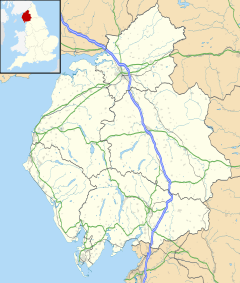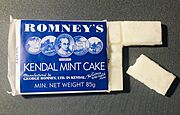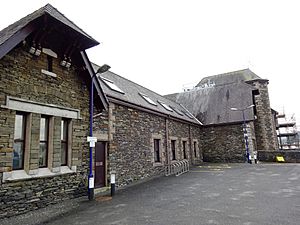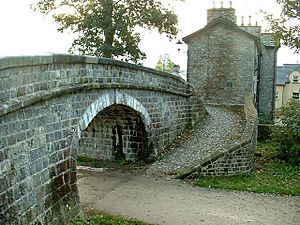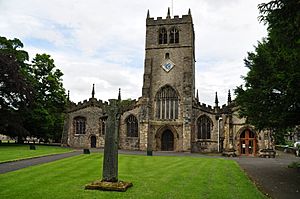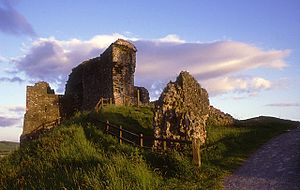Kendal facts for kids
Quick facts for kids Kendal |
|
|---|---|
| Town | |
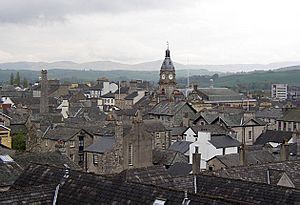 View of Kendal, with the clock tower of the Town Hall (centre) |
|
| Population | 29,593 (2021 census) |
| OS grid reference | SD5192 |
| • London | 223 miles (358.9 km) SSE |
| Civil parish |
|
| Unitary authority |
|
| Ceremonial county | |
| Region | |
| Country | England |
| Sovereign state | United Kingdom |
| Post town | KENDAL |
| Postcode district | LA9 |
| Dialling code | 01539 |
| Police | Cumbria |
| Fire | Cumbria |
| Ambulance | North West |
| EU Parliament | North West England |
| UK Parliament |
|
Kendal, once known as Kirkby in Kendal, is a busy market town in Westmorland and Furness, England. It sits in the valley of the River Kent, which is where its name comes from. The town is just outside the famous Lake District National Park.
Kendal has a long history. In the Domesday Book of 1086, the area was part of Yorkshire. Later, it became the main town for the Barony of Kendal. This area then joined with the Barony of Westmorland to form the historic county of Westmorland. Kendal became the county town in 1889. Today, it is the main administrative centre for the new Westmorland and Furness area, which started in 2023.
The town is about 8 miles (13 km) south-east of Windermere. It is also 19 miles (31 km) north of Lancaster. In 2021, Kendal had a population of 29,593 people. This makes it the second-largest town in Westmorland and Furness. Kendal is famous for its shops, festivals, and historic places like Kendal Castle. It is also known as the home of Kendal Mint Cake. The town's buildings are mostly made of grey limestone, which is why it's sometimes called "Auld Grey Town."
Contents
- What's in a Name?
- Kendal's Past: A Look Back
- How Kendal is Governed
- Kendal's Location and Surroundings
- Kendal's Economy
- Getting Around Kendal
- Learning in Kendal
- Media and News
- Sports in Kendal
- Places to Visit in Kendal
- Famous People from Kendal
- Kendal's Special Way of Speaking
- Mountain Rescue Team
- Twin Towns
- Freedom of the Town
- See also
What's in a Name?
The name Kendal comes from the River Kent and the Old Norse word dalr, meaning "valley." The name of the River Kent itself might come from an old Celtic word. In the Domesday Book, Kendal was called Cherchebi. This Old Norse name meant "church-village." So, for many years, the town was known as Kirkby Kendal. This meant "village with a church in the valley of the River Kent."
Kendal's Past: A Look Back
Kendal has always been a market town. Its centre grew around a main street with narrow passages called "yards." A long time ago, the main business was making woollen goods. This was so important that the town's coat of arms has a symbol of wool. Its Latin motto, Pannus mihi panis, means "Cloth is my bread."
A special type of wool fabric called "Kendal Green" was made here. It was very strong and hard-wearing. Legend says that archers from Kendal wore this fabric. They helped the English win the Battle of Agincourt against the French. Kendal Green was also worn by slaves in the Americas. It even appears in old songs and books. The famous writer Shakespeare mentioned it as the colour worn by foresters.
Kendal Castle has a long and interesting history. It was built on the site of earlier castles. The very first one was a Norman motte and bailey castle. This was on the west side of the town. The castle we see today was built in the late 12th century. It was the main castle for the Barony of Kendal. This area of Westmorland was ruled from here. The castle is most famous as the home of the Parr family. They became owners through marriage during the time of King Edward III of England. Some people say that King Henry VIII's sixth wife, Catherine Parr, was born at Kendal Castle. However, this is probably not true. By her time, the castle was already falling apart. Her father lived in London, close to King Henry VIII's court.
Roman Fort at Watercrook
About 2 miles (3.2 km) south of Kendal town centre, there was an old Roman fort. This site is now called Watercrook. The fort was first built around AD 90 using timber. It was rebuilt with stone around AD 130, during the time of Emperor Hadrian. The Romans left the fort for about 20 years when they went to Scotland. But they rebuilt it again around AD 170. It was used by soldiers until about AD 270.
Today, the stone parts of the fort are buried under a field. Many Roman items found at the site are now kept in the Kendal Museum.
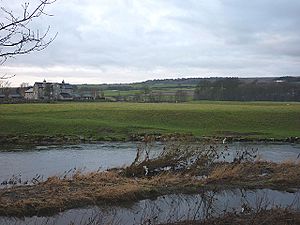
Travel in the Past
Early visitors to Kendal often complained about the difficult roads. They described "nothing but a confused mixture of Rockes and Boggs." Riding horses was the fastest way to travel. The roads were "no better than the roughest fell tracks." In valleys, they were "spongy, miry tracks."
It became clear that local people could not fix these roads alone. In 1703, rules were made to improve the roads. They needed to be good enough for coaches, carts, and carriages. In 1753, the Keighley and Kendal Turnpike road opened. This brought a stagecoach service from Yorkshire all the way to Kendal.
Kendal Mint Cake: An Energy Boost
Kendal is well-known for its Kendal Mint Cake. This sweet treat is made mostly from glucose. It was supposedly found by accident by Joseph Wiper. He was trying to make a clear mint.
Kendal Mint Cake became very popular with explorers. It was taken on many trips to high mountains. This included Mount Everest and K2. It also went to both the North and South Poles. Its fame grew because the original maker's great-nephew was very smart. He decided to sell it as an energy food. He supplied it to Ernest Shackleton's 1914–1917 expedition to Antarctica.
By 1987, the business was sold to another company, Romney's. But there were already other companies making mint cake. Some of them are still in business today.
How Kendal is Governed
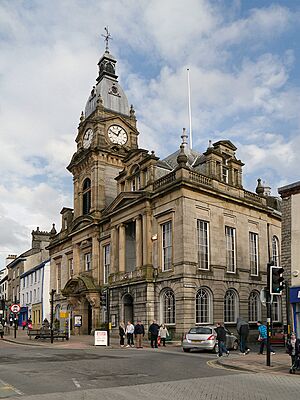
Kendal became a municipal borough in 1835. This meant it had its own local government. In 1908, the areas of Kirkland and Nether Graveship became part of Kendal. From 1888 to 1974, Kendal was the main town for the administrative county of Westmorland. Even though Appleby was the traditional county town.
In 1974, the borough was changed. It became part of the South Lakeland district. Kendal kept its own town council. In April 2023, Kendal became the main town for the new Westmorland and Furness council area. The old councils of Cumbria and South Lakeland were closed at the same time.
Kendal's MP
Kendal is part of the Westmorland and Lonsdale area for Parliament. Tim Farron is the current Member of Parliament (MP) for this area. He represents the Liberal Democrats party.
Kendal's Location and Surroundings
Kendal is built on the River Kent. It is mostly surrounded by low hills. These include Scout Scar to the west and Potter Fell to the north. To the east are Benson Knott and Helm Hill. South of Kendal, the River Kent flows through farmland. It reaches the sea at Morecambe Bay.
Even though Kendal is close to the Lake District National Park, it is not actually inside the park. The park was created in 1951. Kendal is surrounded by many small villages. This makes it an important place for shopping and business for a large area. It is often called "The Gateway to the Lakes."
 |
Burneside |  |
||
| Underbarrow and Bradleyfield | Sedbergh | |||
| Oxenholme |
Weather in Kendal
Kendal has a mild, wet climate. This means it has warm summers and mild winters. It rains throughout the year. In July and August, the average high temperature is 19°C (66°F). The average low is 11°C (52°F). In January and February, the average high is 6°C (43°F). The average low is 1°C (34°F).
Kendal's Economy
Kendal's wealth first came from making cloth. In the 1800s, it became known for making snuff and shoes. The K Shoes company was a big employer until its factory closed in 2003.
Today, several businesses are still based in Kendal. These include Gilbert Gilkes & Gordon, which makes pumps and turbines. James Cropper paper makers are based nearby in Burneside. They make the paper for the Remembrance poppies for free. Other companies include Mardix (electrical equipment), Lakeland (kitchenware), and Kendal Nutricare (baby milk).
Tourism is now a very important business in Kendal. Many people work in hotels, shops, and attractions. There is also a growing number of IT and design companies. This is because of better internet access. On February 26, 2003, Kendal became a Fairtrade Town. This means it supports fair prices for goods from developing countries.
Getting Around Kendal
Kendal railway station is on the Windermere Branch Line. You can catch trains from here to Windermere in the north. You can also go south to Oxenholme and Lancaster. These stations are on the main West Coast train line.
Local buses run from Kendal bus station to places like Ambleside, Barrow-in-Furness, and Keswick. Most of these services are run by Stagecoach. Long-distance National Express buses also go to Preston and Birmingham.
Kendal is about 8 miles (13 km) from the M6 motorway. The A591 road bypasses Kendal on the west side. This road connects Kendal to Windermere and Keswick. The A590 leads to Barrow. Kendal is also the end point of the A65 road to Kirkby Lonsdale and Leeds. The A6 road also goes to Penrith.
The Lancaster Canal reached Kendal in 1819. But the northern part of the canal can no longer be used by boats. This is because the M6 motorway was built over it. Part of the canal was drained and filled in. The canal's path through Kendal has now been built over. However, the old canal towpath is still a walking path through the town. There is a group working to bring the canal back to life all the way to Kendal.
Learning in Kendal
The Queen Katherine School is a secondary school in Kendal. It also has a sixth form for older students. Kirkbie Kendal School is another secondary school. It used to be called Kendal Grammar School. It focuses on business and enterprise. Famous historian David Starkey went to this school.
Kendal College offers courses for further and higher education. It also provides training for people working in different jobs.
Media and News
Local news and TV shows for Kendal come from BBC North West and ITV Border.
Kendal has several local radio stations. These include BBC Radio Cumbria (95.2 FM), Smooth Lake District (100.1 FM), and Heart North West (103.2 FM). There are also online community radio stations like Lake District Radio and Bay Trust Radio. The town's local newspaper is The Westmorland Gazette.
Sports in Kendal
Kendal Town Football Club plays in the North West Counties Premier Division. Their home games are at Parkside Road Stadium.
Kendal RUFC plays in the 5th level of English rugby. Their home games are at Mint Bridge Stadium. This stadium can hold 3,500 people.
Places to Visit in Kendal
- Kendal Museum is one of the oldest museums in the country. It has exhibits about local history, culture, and nature. You can also see items from Roman Britain and Ancient Egypt.
- Abbot Hall Art Gallery is in a beautiful Georgian house. It holds important art shows. Its permanent collection includes works by famous artists like George Romney and J. M. W. Turner.
- The Museum of Lakeland Life is in the old stables of Abbot Hall. It shows what farming life was like in the Lake District. It also has a collection of books and items belonging to author Arthur Ransome.
- Castle Howe was Kendal's very first castle.
- Kendal Castle is to the east of Castle Howe. It was likely built while Castle Howe was still in use.
- The Friends' Meeting House is home to the Quaker Tapestry. This is a large, colourful embroidery telling the story of Quakers.
- The Brewery Arts Centre offers many activities. These include theatre, dance, art shows, movies, and music. They also have workshops and youth drama.
- The Queen Katherine Street drill hall was used to gather soldiers during the First World War.
- The Lakes International Comic Art Festival happens in Kendal every October. It's a big event for comic book fans.
- Other interesting places include Kendal Leisure Centre and Kendal Parish Church (Holy Trinity).
Famous People from Kendal
Many interesting people have connections to Kendal:
- Dave Allen (born 1955) – Bass player for the band Gang of Four.
- Desmond Bagley (1923–1983) – A writer of thrilling adventure novels.
- Jonathan Dodgson Carr (died 1884) – Founder of Carr's bread makers.
- John Cunliffe (1933–2018) – Children's author, who created the popular character Postman Pat.
- John Dalton (1766–1844) – A famous chemist and physicist.
- Sir Arthur Eddington (1882–1944) – A well-known astrophysicist.
- Tim Farron (born 1970) – The current Member of Parliament for Westmorland and Lonsdale.
- Maurice Flitcroft (1929–2007) – A British golfer, whose life story was made into the film The Phantom of the Open.
- Daniel Gardner (1750–1805) – A portrait painter.
- Steve Hogarth (born 1959) – The lead singer of the rock band Marillion.
- Geoffrey Kendal (1909–1998) – A Shakespearean actor.
- George Romney (1734–1802) – A famous portrait painter.
- David Starkey (born 1945) – A historian who specializes in the British constitution.
- Alfred Wainwright (1907–1991) – A famous guidebook author and walker.
- Wild Beasts – An indie-rock band.
- Mark Wilson (born 1989) – A rugby player for Newcastle Falcons and England.
Kendal's Special Way of Speaking
The way people speak in Kendal is called Kendalian. It is a type of the Cumbrian dialect that is spoken in the areas around the town.
Mountain Rescue Team
Kendal has a local team of volunteers who help with mountain search and rescue. They are based at Busher Walk. This team, along with others nearby, helped after the Grayrigg derailment in 2007. The Kendal Mountain Rescue Team is part of a larger group called the Lake District Search and Mountain Rescue Association.
Twin Towns
Kendal is twinned with two other towns:
- Killarney, Ireland
- Rinteln, Germany
Freedom of the Town
Some people and military groups have been given the special honour of "Freedom of the Town" of Kendal:
Individuals
- Sir Arthur Eddington: 1930
Military Units
- The Border Regiment: October 25, 1947
- The King's Own Royal Border Regiment: October 1, 1959
- The Duke of Lancaster's Regiment: July 1, 2006
See also
 In Spanish: Kendal para niños
In Spanish: Kendal para niños


